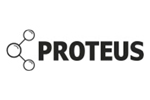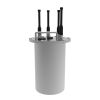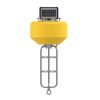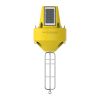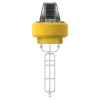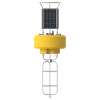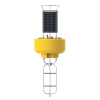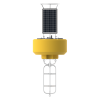Proteus Multi-Parameter Water Quality Sensors
Features
- Built-in wiper cleans optical sensors prior to each measurement
- Optional internal battery pack for standalone deployments
- SDI-12 and RS-485 Modbus output for integration with data loggers & PLC's
- Expedited repair and warranty service
- Lifetime technical support
- More
Overview
The Proteus is a unique, scientifically-proven multi-parameter probe platform that uses both fluorescence and patented algorithms to monitor biochemical oxygen demand (BOD), chemical oxygen demand (COD), total organic carbon (TOC), dissolved organic carbon (DOC) and total coliforms, fecal coliforms and E. coli coliforms in real-time. The instrument is designed for use in drinking water, wastewater, industrial, process, recreational swimming areas, aquaculture and food & beverage applications:
- Biochemical Oxygen Demand (BOD): BOD is a measure of the amount of oxygen that is used by bacteria and other microorganisms during the aerobic decomposition of organic matter.
- Chemical Oxygen Demand (COD): COD is a measure of the amount of oxygen that is required to dissolve both organic and inorganic matter with the water.
- Total Organic Carbon (TOC): TOC is a measure of the total amount of carbon present in organic compounds in a water source.
- Dissolved Organic Carbon (DOC): A subset of TOC, dissolved organic carbon is the fraction of TOC which can pass through a 0.22 - 0.7µm pore size filter.
- Total Coliforms, Fecal Coliforms and E. coli Coliforms: Coliforms are rod-shaped, gram negative bacteria. Total coliforms (TC) include all coliform bacteria that are present within the water source.
Sensor Options
Proteus can be fitted with up to 12 different sensors to output over 30 parameters on a single instrument. Sensor options include temperature, conductivity, pH, ORP, dissolved oxygen, turbidity, CDOM, tryptophan, chlorophyll, blue-green algae, depth, and more. A central wiper on the turbidity sensor cleans the optical sensors prior to each measurement, reducing the maintenance requirements when continuously deployed. The probe can also be outfitted with a cabled Bluetooth battery pack for spot sampling with any Android/iOS device.
Includes
Included with the purchase is the Proteus base unit with temperature sensor, calibration cup, sensor guard, serial communication cable, serial to USB adapter, digital manual and Proteus Software Manager. Both SDI-12 and RS-485 Modbus RTU are standard outputs for interfacing with environmental data loggers and PLC's. Pair the multi-parameter probe with the NexSens X-Series data loggers and CB-Series buoys for cloud-based data in remote locations via WQData Data LIVE and cellular or satellite telemetry.
| BOD Parameter Specifications | |
| Units | BOD mg/l |
| Range** | 0-2000 mg/l |
| Resolution | 0.01 mg/l |
| Accuracy | ±5 % of reading* |
| Comments | Local site calibration can improve accuracy |
| Coliform Counts Parameter Specifications | |
| Units | CFU/100 m |
| Range** | >1 count/100ml |
| Resolution | 1 count/100ml |
| Accuracy | ±10 Coliforms* |
| Comments | Local site calibration can improve accuracy. Can be used for fecal coliforms, E. coli or total coliforms |
| COD Parameter Specifications | |
| Units | COD mg/l |
| Range** | 0-4000 mg/l |
| Resolution | 0.01 mg/l |
| Accuracy | ±5 % of reading* |
| Comments | Local site calibration can improve accuracy |
| DOC Parameter Specifications | |
| Units | DOC mg/l |
| Range** | 0 - 3000 mg/l |
| Resolution | 0.01 mg/l |
| Accuracy | ±5 % of reading* |
| Comments | Local site calibration can improve accuracy |
| TOC Parameter Specifications | |
| Units | TOC mg/l |
| Range** | 0 - 3000 mg/l |
| Resolution | 0.01 mg/l |
| Accuracy | ±5 % of reading* |
| Comments | Local site calibration can improve accuracy |
| General Specifications - Proteus 35 | |
| Diameter | 89 mm (3.5") |
| Length - w/o Battery Pack | 483 mm (19") |
| Weight - with IBP | 2.85 kg (6.28 lbs) |
| Number of Sensors | Up to 11 |
| Optional Battery Pack | 8 “C” cells |
| General Specifications - All Versions | |
| Internal Power Battery Life | 1 to 24 month depending on sensors / logging rates |
| External Power | 5-15 vdc |
| Operating Temperature | 0 to 50 °C non-freezing |
| Calibrated Range | 0 to 30 °C non-freezing |
| Depth Rating | 200 m |
| Communications | USB, RS232, Modbus RS485, SDI-12 |
| Sample Rate | 1 Hz |
| Data Memory | >1,000,000 logged readings |
| Logging Rates | 1 second to 1 day |
| Warranty | 2 years (All sensors excluding ISE’s) |
*providing adequate field calibration
**customized ranges are available
- (1) Proteus 35 base unit with temperature sensor
- (1) Calibration cup
- (1) Sensor guard
- (1) Serial communication cable
- (1) Serial to USB adapter
- (1) Digital manual
- (1) Proteus Software Manager
- Proteus Multi-Parameter Water Quality Sensor Specifications
- Proteus Multi-Parameter Water Quality Sensor Brochure
- Proteus Multi-Parameter Water Quality Sensor Manual
- Proteus Multi-Parameter Water Quality Sensor SDI-12/Modbus Manual
- Proteus Multi-Parameter Water Quality Sensor Power Options
- Proteus Multi-Parameter Water Quality Sensor Tech Note
In The News
It’s Time to React to Water Quality: Proteus Multiparameter Probe aboard NexSens Buoy
Water quality monitoring is essential for safeguarding public health, protecting ecosystems, and ensuring the sustainability of water resources. Contaminants such as industrial pollutants, agricultural runoff, and sewage discharge can severely impact aquatic life and pose serious risks to human health if left unchecked. Traditionally, water quality monitoring has been a slow and labor-intensive process, requiring samples to be collected, transported to a lab, and analyzed—a process that can take days. However, with the advancement of real-time sensor technology, environmental agencies, researchers, and industries can now monitor water quality instantly.
Read MoreFrom Paddles to Phytoplankton: Studying Vermont’s Wildest Lakes
For six months of the year, Rachel Cray, a third-year PhD student at the Vermont Limnology Laboratory at the University of Vermont, lives between a microscope and her laptop, running data. For the other six months, she is hiking and canoeing four of Vermont’s lakes, collecting bi-weekly water samples. Cray studies algal phenology across four lakes in Vermont, US, that have low anthropogenic stress—or in other words, are very remote. Funded by the National Science Foundation Career Award to Dr. Mindy Morales, the lakes Cray researches part of the Vermont Sentinel Lakes Program, which studies 13 lakes in the area and, in turn, feeds into the Regional Monitoring Network, which operates in the Northeast and Midwest US.
Read MoreReimagining Water Filtration: How Monitoring and Science Enhance FloWater Filtration Systems
Over 50% of Americans think their tap water is unsafe , according to the Environmental Working Group (EWG). Other recent surveys have found that number to be as high as 70% of persons surveyed. Whether due to increased public awareness of water quality issues or confusion about how municipal water sources are regulated, there is a clear distrust of tap water in the United States. According to industry expert Rich Razgaitis, CEO and co-founder of the water purification company FloWater, this issue creates a damaging cycle. Razgaitis explained that the health and environmental problems associated with contaminated water aren’t the only issues. As people become increasingly aware that some tap water is unsafe, they resort to bottled water.
Read More














